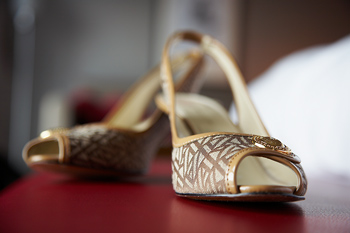
by Rabbi Elisa F. Koppel I’m not ashamed to admit it: I like shoes. I’m not quite obsessive about them, but I probably have more pairs of shoes than I need, and I’m always finding new ones – you know, the ones that would be perfect with that one outfit.
More than one might expect, my love of shoes and my rabbinate come together.
First of all, I must mention that the first temple president I worked with as a rabbi was in the shoe business, so I became quite aware of what was on my feet each time I was on the bimah early in my career. It’s always a challenge to find shoes that work from a fashionable standpoint, and are also comfortable enough to stand in for long periods of time. It’s always a balance. There is, of course, the hunt for Biennial Shoes every other year. And the absolute need for rain boots at camp each summer. And the opportunity, every now and then, to pull out my flowered Doc Marten boots (usually because they’ll go perfectly with my Purim costume)!
But the time at which my thoughts of spiritual matters and spirit-shoe-al matters (pardon the bad pun) some together most meaningfully is each year on Yom Kippur. One of the traditions of Yom Kippur is to not wear leather shoes. It’s one of the “afflictions” that the rabbis outlined for the day. For me, this has been a meaningful aspect of the holiday. I’ll admit, wearing Chucks or Crocs in some years has also been the more comfortable choice, but to me that’s somewhat of a side benefit; it’s really about the symbolic meaning of the gesture. Others, by the way, have argued that because affliction was the purpose, one should wear the most uncomfortable heels possible. I applaud that choice for them – and love that Reform Judaism gives us the ability to interpret things in different ways.
But that answer doesn’t work for me.
To me, the affliction is not about discomfort; it’s about not using things that not everyone has. Leather is a sign of luxury. By not wearing leather, I’m reminded of the fact that many people can’t afford leather shoes (or really nice heels, for that matter). In addition, as tradition tells us that all souls are equal on Yom Kippur, it doesn’t feel right to wear something that’s made out of one of God’s creations, on that of all days. Yom Kippur, as I see it, is sort of the great equalizer. It’s the day where we all go without food and without luxury. Wearing non-leather feels right to me and helps me to be more aware of what the purpose of the day is. It also allows me to do something different than what I do every other day. It sets the day apart from the rest of the calendar. To me, all of that makes it a powerful act.
This year, by the way, I’m going to be wearing Tom’s. They’re a little bit nicer than sneakers, I can get vegan ones, and a pair of shoes goes to someone who wouldn’t have them otherwise. Seems only appropriate.
So… what shoes are you wearing for Yom Kippur?
Rabbi Elisa F. Koppel is the Acting Associate Rabbi at Temple Beth-El in San Antonio, TX. She blogs personally at Off the REKord. Having recently moved to San Antonio, she has begun to wonder how long it will take before she adds a few pairs of cowboy boots to her shoe collection. Originally posted at Kol Isha: The Blog of the Women's Rabbinic Network
Related Posts

Harnessing the Power of our Mothers Around the Seder Table

Melding Tradition and Innovation: Our Interfaith Toddler Naming Ceremony

